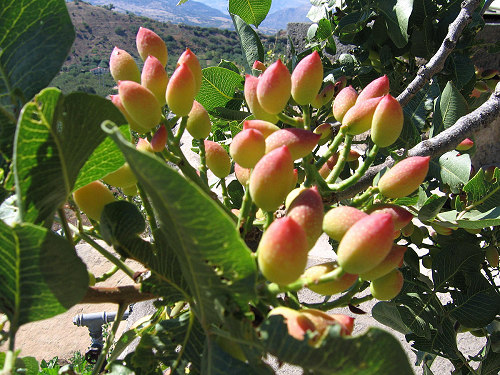Growing Pistachio:
Pistacia vera
Back to Fruit, Berries and Nuts
Botanical Overview
A member of the Cashew and Sumac family (Anacardiaceae), the Pistacia genus has 12 species, of which Pistachio, grown for its edible nuts, is the most well known.
Description
Form:
Tree.
Lifespan:
Several hundred productive years.
Leaf retention:
Deciduous.
Growth rate:
Slow.
Mature Size:
20-30' (6-9m) high and as wide for the male tree, but in cultivation they seldom attain that
height.
Female trees are usually smaller.
Flowers:
Clustered, tiny, brownish-green, separate male and female flowers on separate trees.
The flowers have no petals, do not produce nectar, and the females do not attract
pollinating insects.
Pistachio trees are planted in a ratio of one male upwind for every 5 to 8 females, or in
some cases, a male tree branch is grafted onto a female tree.
Bloom:
Late spring. Male flowers may bloom before female and some farmers will store the pollen and
manually pollinate the female later. Pistachio trees are alternate bearing, with female
trees producing fruit heavily every other year, and using the process of bud dropping in
alternate years to achieve this. Pruning in heavy years is the best way to reduce, but not
eliminate, alternate bearing.
Self-fruitful: No. Wind blows pollen from male to
female flowers.
Years before fruiting:
5-8 years. Full production may not be attained until 15 or 20 years.
Fruit:
Green, thin flesh (the mesocarp) covers a thin hard shell (the endocarp) enclosing a seed
called the pistachio nut. When the nut is fully ripe, the outer fruit turns red and wrinkled
and starts to separate from the shell, which usually splits open. Nuts vary from yellow to
green inside, with green being the most prized. Some shells will be blank, lacking nuts.
Blanking occurs most often in "off" years when the tree bears little or no fruit.
Maintaining proper irrigation and boron levels reduces blanking. It is desirable for shells
to split and failure to do so can be caused by drought stress.
Normal splitting rates are 50-75%.
The nuts contain a high quality oil but the nut itself is more valuable.
Months for fruit to ripen:
4-5. The nuts are harvested by shaking or pounding the tree, collecting the fallen nuts, and
removing the outer fleshy layer from the shell with a squeeze between thumb and finger.
Storage after harvest:
Frozen nuts last for months before processing. Otherwise, they must be hulled and dried
within 24 hours after harvest to avoid aflatoxin infection.
Leaves:
Green leaflets, oval with a tip on the end, in sets of five leaflets.
Stems:
No thorns.
Roots:
The species Pistacia integerrima is often used as a rootstock.
It is vigorous, resistant to fungal diseases and nematodes, and produces extensive, deeply
penetrating roots.
That species and its hybrid are named Pioneer Gold and Pioneer Gold II.
Cultivars of Note:
'Peters' Male tree, heavy pollen producer, blooms
before and during 'Kerman'.
'Kerman' Female tree, bearing heavily but in
alternate years, producing above average size nuts. Late blooming.
Wildlife:
The nuts attract birds and squirrels.
Toxic / Danger:
Pistachio trees are not poisonous to humans or pets but are toxic to horses.
Origin:
Desert regions from Syria to Afghanistan and possibly India.

Cultivation and Uses
USDA hardiness zones:
8b-10. Pistachio trees need a long, hot, dry summer and a moderately cold winter.
The standard rootstock should not be exposed to temperatures below 10°F (-12°C).
Summer humidity results in extensive fungal disease and poor quality nuts.
Chill hours:
550-600 to achieve 50% bloom. Lower chill hours result in delayed blooming, extended
blooming, and a mismatch between male and female bloom times.
In hot climates, the female tree may produce mostly empty shells without nuts.
Heat tolerant:
Yes.
Drought tolerant:
Yes.
Sun:
Full sun.
Planting:
Locate these trees where they receive full sun from mid-spring to mid-fall.
They should be placed in an area where cold air collects in the winter to improve winter
chill hours.
The trees can be planted 11' (3.3m) apart.
This tree is not suitable for a container after the first three years and should be in
the ground.
Soil:
Very well draining, deep, dry, sandy loam with a high calcium carbonate content, pH 7.0-7.8
(neutral to slightly alkaline). This tree is very tolerant of salinity and boron.
Fertilize:
Use organic fertilizer every month from early spring to mid summer.
Water after becoming established:
Deep water once every 7-10 days in spring and
summer until harvest is over. Deep water once a month in winter.
Mulch:
Organic mulch reduces evaporation loss and lessens bud drop in heavy crop years.
Prune:
Blooms are produced on one year old wood. Any winter pruning may significantly lower nut
production.
Litter:
Leaves in fall, flower buds, nuts if not harvested.
Propagation:
Grafted cuttings.
Pests:
This tree is prone to root rot in poorly draining soil. It is prone to Verticillium wilt in
soils where other plants have exhibited that disease, and prone to other fungal and bacterial
diseases in poor growing conditions.
Uses:
Edible nuts. Male trees can produce resin used in lacquers and varnishes.
Comments
This is a northern desert tree that expects a dry climate, with some underground
water, and a prolonged, moderately cold winter. It is not suited to nut production in
southwestern desert regions which produce 300 chill hours or less. However, it can easily be
grown as an ornamental in those regions.
Latest update: May, 2025
© 2008-2025 by GardenOracle.com

